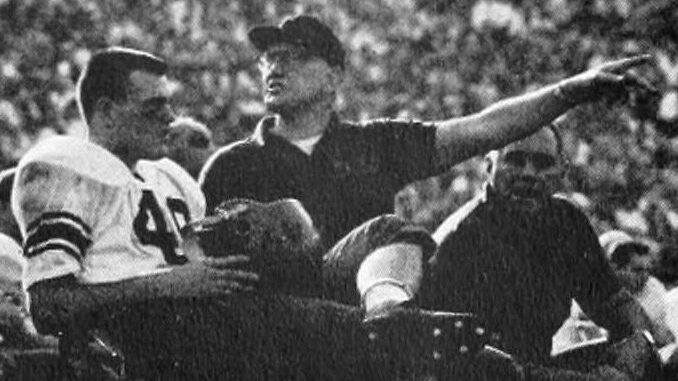
Item: Syracuse athletics announced last week that three of the five inaugural members of the school’s Ring of Honor within the JMA Wireless Dome, will be officially saluted at intermission of the North Carolina State football game on October 15 (3:30 p.m. ET / ACC Network). The trio of Number 44 legends Jim Brown, Ernie Davis, and Floyd Little will be honored by family representatives, school administrators, and hopefully a large turnout of spectators during the halftime festivities. Those three join Jim Boeheim, Dwayne “Pearl” Washington, and Roy Simmons Jr. with their names emblazoned on the façade just below the suite seating on the north side of the building. We have a nomination for the next two deserving names to join that exclusive group.
As per the university release announcing the October 15 ceremony, “the Ring of Honor (established in pandemic-plagued 2020) is an honor bestowed upon individuals named as one of Syracuse University’s most outstanding student-athletes or coaches to compete and/or coach their associated collegiate sport.”
When you look at the Ring of Honor names listed inside the Dome you see the current six-members’ names beginning above seating Section 114 and extending left-to-right to Section 118. There’s a blank orange-painted facing that contains space to add a couple of more names over to Section 119.
Here’s a look at the careers of the two names we think should next appear on that facing as certified trailblazers of Syracuse athletics:
Floyd “Ben” Schwartzwalder
Like Boeheim did in building ‘Cuse basketball from a regional to national name, Coach Ben was the architect of the football program’s rise to national prominence between 1949-1973, and, of course, was the coach of Ring of Honor members Brown, Davis, and Little.
Syracuse football was down and out when Schwartzwalder, who grew up in West Virginia and graduated from WVU, took over the program in 1949, having won only 11 games in the previous five years at the tail end of World War II.
During the war, Schwartzwalder was a military hero, a paratrooper, part of the D-Day invasion in June 1944 fighting behind enemy lines. He earned a Purple Heart, Bronze Star, Silver Star, and Presidential Unit Citation.
Following a 4-5 campaign in ’49, Syracuse football would not have a losing season for the next 22 years, up to Schwartzwalder’s final two campaigns in 1972 and 1973.
In between, he led the Orangemen to their most glorious season in 1959, voted the national champions and capped off by a Cotton Bowl win over Texas, one of seven bowl games during his tenure as the school’s all-time winningest coach with a record of 153-91-3 (.626).
Like Boeheim, Schwartzwalder, who died in 1993, had his undesirable moments as well. In 1970, nine African-American players, incorrectly referred to as the ‘Syracuse 8’, boycotted the season citing racial inequality surrounding issues such as academic counseling, medical care, and integrating the coaching staff. (The nine players were awarded the Chancellor’s Medal in 2006, the highest honor the university bestows to an individual for outstanding achievement.)
While Boeheim played himself in the 1994 movie “Blue Chips” starring Nick Nolte, Schwartzwalder was portrayed by Dennis Quaid in the 2008 film “The Express” chronicling the life of Davis, the first African-American to win the Heisman Trophy in 1961.
From 1993-2011, the annual winner of the Syracuse-West Virginia game received the Ben Schwartzwalder Trophy, that’s a tradition that somehow needs to be revived.
» Related: The case to eliminate all FCS opponents from future Syracuse football schedules
Doris R. Soladay
Before you say, “Who?” a brief history lesson. During this year’s 50th anniversary celebration of Title IX which greatly expanded the opportunities for women to compete in collegiate athletics, the school’s first women’s athletic director was Soladay, who held that post from 1975-1982 prior to merging into one office under the direction of Jake Crouthamel and assuming the Associate Director of Athletics title.
Simply put, Soladay, although not a coach of a program, set the undeniable course for many of the great women athletes to have ever worn a SU uniform before retiring in 1995, by establishing scholarships and increasing budgets for each women’s sports team under the original Orange Plus support umbrella.
We got to know the genial New Mexico native as she transitioned her Syracuse tenure from a physical education instructor to overseeing all the women’s varsity programs. As stated in the biography accompanying her induction in the Greater Syracuse Sports Hall of Fame in 2008, “she was fair, honest, dedicated and a gem of a person who always saw the glass half-full,” and we can certainly concur.
Besides her Hall of Fame selection, Soladay was also a recipient of the ECAC’s Jostens Distinguished Service Award for career achievements, and a SU Varsity Club “Letterwinner of Distinction” honoree.
Soladay died in 2001 but her legacy lives forever with the presentment each year of the Soladay Award, the athletic department’s most prestigious honor given to one male and one female student-athlete who best exemplifies her professional and personal life missions.
For more Syracuse coverage, like us on Facebook, follow us on Twitter and Instagram, and listen to our podcast.

